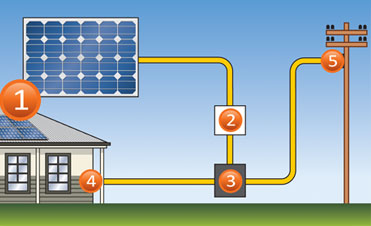FAQ's
Besides reducing household’s carbon footprint, a solar system can generate huge savings on your electricity bill in two distinct ways. Firstly, by generating your own electricity from the solar panels you reduce the electricity you need to buy from your power provider. Secondly, any excess “Green” electricity your system produces is sold back to the power provider. These two benefits mean many households will be able to greatly reduce their electricity bill. Another often overlooked benefit is that the solar units increase both the energy rating and value of your house.
Grid connect solar panel systems are connected to the electricity supply grid. An inverter converts DC low voltage power generated by the solar panels to 240V AC household supply. The inverter also manages how much electricity is drawn from or fed back into the grid. When excess “Green” electricity is fed into the grid, the meter ticks backwards, so the household only pays the difference between what is fed and drawn.
Yes, by reducing Australia’s dependency on electricity generated from coal, we not only reduce CO2 emissions, we also reduce the demand on water that power companies require to generate this electricity. Currently 130 billion litres of drinking water is used just to generate coal-based electricity. Furthermore, if more Australians installed solar panel systems it will reduce the stress on our electricity grid. This in turn will minimise the number of blackouts occurring during times of peak electricity use.
Thanks to the Government’s Solar Credits scheme the cost to the customer is greatly reduced. Find out more at Rebates and Incentives, or simply call us today for an obligation free quote.
The amount of roof space required depends on the size of the system installed. For example, a 1.5Kw system requires about 12m2 of roof space. This should be on an un-shaded and preferably a north-facing part of the roof. The system is modular and can therefore be arranged in a way that best suits the roof.
Yes, all Solar Generation panels have a minimum 10 year structural warranty as well as a 25 year performance guarantee.
Yes, all of our panels and inverters meet Australian and international standards and are listed on the Clean Energy Councils and Western Powers approved lists.
Yes, all of our installers are licensed electricians and are accredited in Design and Installation of PV systems by the Clean Energy Council.
Solar Photovoltaic systems rely on sunlight and ultra violet rays, not heat. So while there may be fewer hours of sunlight in winter, the actual conversion of power is unaffected by the change in season. However, you will benefit from extended hours of sunlight in the summer.
For safety reasons, in the event of a blackout or power failure, your solar PV system will stop producing electricity. This safety measure is mandatory and has been put in place to protect anyone working on the blacked-out grid system. As soon as the grid is back online, your solar PV system’s ability to generate will be restored.
When you install solar power and other renewable energy generating sources, you are helping to reduce carbon emissions. This entitles you to create carbon offset credits called Small-scale Technology Certificates STCs. These credits are a tradable commodity just like shares on the Australian Securities Exchange.
Like other commodities, the price of STCs is not fixed and varies with supply and demand. One STC equals 1MWh of generation from a renewable source and is part of the Mandatory Renewable Energy Target. This target is an industry development mechanism created by the Government in 2001.
Under the new RET (Renewable Energy Target), STCs may be traded to an electricity supplier for a point of sale discount on their renewable generation unit – saving themselves the value of the STCs generated.
RECS are based on zones that are set by the Office of the Renewable Energy Regulator. There are 4 zones based on how much sun a specific suburb gets – with zone 1 being the sunniest down to zone.
Speak to one of our Solar Generation Consultants who will guide you through the process.
Also, ask us about our interest free finance options!
About 3 to 4 hours
Although it is optimal to install solar products on the north-facing side of a roof, it is also possible to install a solar PV system on the east or west facing side of a roof, as long as there is sufficient space. However, this will not produce the same results as a north-facing installation.
This depends on your roof space and the size of the inverter. If you have sufficient roof space and additional capacity in the inverter you could increase the size of your system. Or you could add a second system to your roof.
Yes.
As solar PV systems only produce electricity when they are exposed to sunlight, they do not produce electricity at night. At night you will need another source, such as electricity from the grid
Australia is world famous for its sunny climate however we do not always best use our abundance of sunlight. Sunlight is a natural clean energy resource and once you pay the initial outlay for the solar system to be installed all the electricity you collect is absolutely free. Your solar system lifespan is over 25 years so imagine how much it could reduce your household running costs over this time.
Roof mounting systems can be installed to angle your solar panels at an adequately slanted position so that they can still collect the maximum electricity from the sun.



